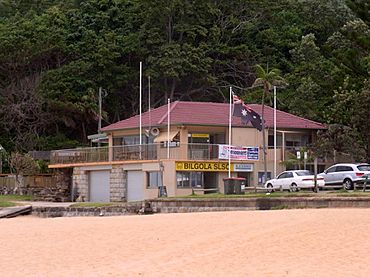Bilgola Beach, New South Wales facts for kids
Quick facts for kids Bilgola BeachSydney, New South Wales |
|||||||||||||||
|---|---|---|---|---|---|---|---|---|---|---|---|---|---|---|---|

Bilgola Surf Lifesaving Club
|
|||||||||||||||
| Elevation | 14 m (46 ft) | ||||||||||||||
| Location | 33 km (21 mi) north-east of Sydney CBD | ||||||||||||||
| LGA(s) | Northern Beaches Council | ||||||||||||||
| State electorate(s) | Pittwater | ||||||||||||||
| Federal Division(s) | Mackellar | ||||||||||||||
|
|||||||||||||||
Bilgola Beach is a beautiful suburb located in Sydney's Northern Beaches area, in New South Wales, Australia. It is about 33 kilometers north-east of the main city center of Sydney. Bilgola Beach and the nearby Bilgola Plateau became their own separate suburbs in 2012. Before that, they were both part of a larger area simply called Bilgola.
Contents
Where is Bilgola Beach?
Bilgola Beach is found on the eastern side of the Barrenjoey Peninsula. This means it's right next to the Tasman Sea. To the north of Bilgola Beach, you'll find Avalon Beach. To the south, you'll find Newport.
The land behind Bilgola Beach rises very steeply. This leads up to Bilgola Plateau. On the western side of the peninsula, the land goes down towards Clareville.
History of Bilgola
The name "Bilgola" comes from an Aboriginal word. It might be Belgoula, which means "swirling waters." Another idea is that it means "a pretty beach with steep slopes, covered with cabbage palms." A surveyor named James Meehan wrote down the word Belgoula in his records back in 1814.
Later, in 1822, a person named Robert Henderson was given a large piece of land, about 100 acres. He named his land "Belgoola." Over time, the area started to be called the simpler name, "Bilgola."
The McLurcan Family and Their Home
From the early 1900s, the McLurcan family owned a lot of land in the Bilgola area. Mrs. McLurcan was quite famous for her cookery book, which was called 'Mrs. McLurcan's Cookery Book'. Their big family home was surrounded by many cabbage tree palms. These trees are still a special feature of the area today.
Road Plans That Changed
In the 1960s, there were plans to build a bridge. This bridge would have bypassed a very twisty road known as the 'Bilgola Bends'. This road connects the northern and southern parts of Bilgola. The bridge was never built. However, some extra land was added to remove a very sharp bend at the southern end of the road. This was done to prepare for the bridge construction. That sharp bend is still there, but the added land now forms a small grassy area. From this spot, you can get a great view of Newport Beach.
Who Lives in Bilgola?
In 2011, a survey counted the people living in Bilgola. At that time, there were 3,863 residents in the area that is now Bilgola Beach and Bilgola Plateau. Most people (about 71.7%) were born in Australia. Many others came from England (9.4%), New Zealand (1.7%), and the United States of America (1.4%). People also came from South Africa and Germany.
Most people (89.7%) spoke only English at home. However, other languages were also spoken, like German, Italian, French, Swedish, and Dutch. When asked about their religion, many people said they had no religion (27.8%). Others were Anglican (24.9%) or Catholic (21.2%).
Getting Around Bilgola
The main road that connects the northern part of the Barrenjoey Peninsula to the rest of Sydney is called Barrenjoey Road. This road goes through Hewitt Park. It runs along the cliffs between Bilgola headland and Bilgola South headland. This important road actually separates Bilgola Plateau from Bilgola Beach.
Fun and Sports at Bilgola
Bilgola Beach is a great place for sports and recreation!
Bilgola Surf Life Saving Club
The Bilgola Surf Life Saving Club is located right on Bilgola Beach. This club was started in the summer of 1949. The building for the club house began to be built in 1950. Surf life saving clubs are very important. They help keep people safe while they are swimming and enjoying the beach.
Avalon Bilgola Amateur Swimming Club
If you love swimming, the Avalon Bilgola Amateur Swimming Club is for you! This club swims at the Bilgola Rock Pool. They meet on Saturday mornings during the summer months. The club was first formed in 1961.

